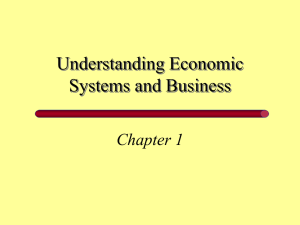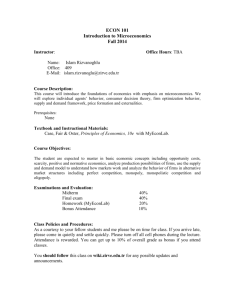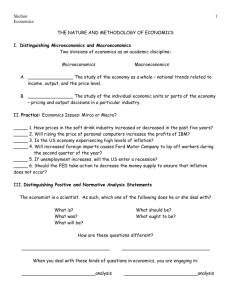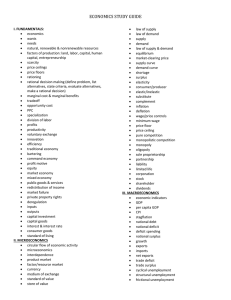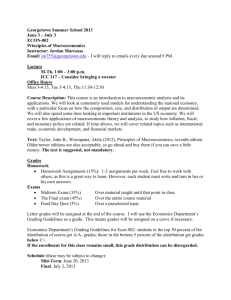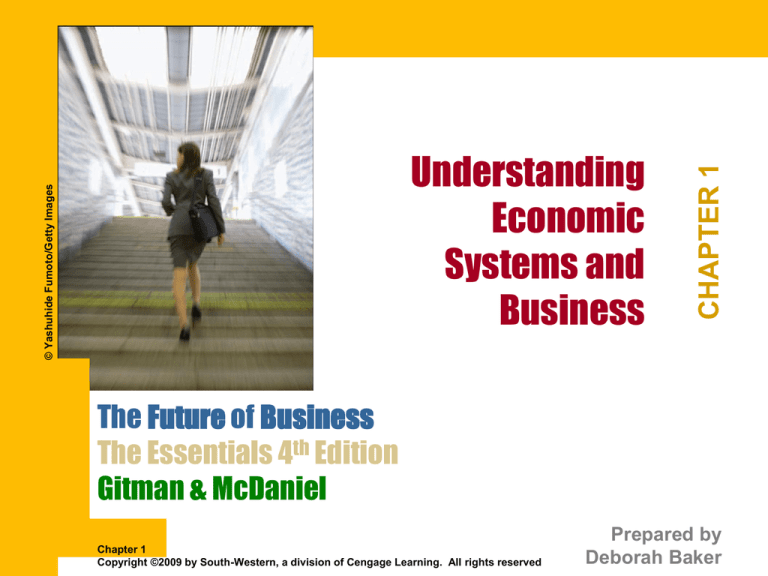
CHAPTER 1
© Yashuhide Fumoto/Getty Images
Understanding
Economic
Systems and
Business
The Future of Business
The Essentials 4th Edition
Gitman & McDaniel
Chapter 1
Copyright ©2009 by South-Western, a division of Cengage Learning. All rights reserved
Prepared by
Deborah Baker
CHAPTER 1
Learning Goals
1 How do businesses and not-for-profit organizations
help create our standard of living?
2 What are the sectors of the business environment, and
how do changes in them influence business decisions?
3 What are the primary features of the world’s economic
systems, and how are the three sectors of the U.S.
economy linked?
4 How do economic growth, full employment, price
stability, and inflation indicate a nation’s economic
health?
2
CHAPTER 1
Learning Goals (continued)
5 How does the government use monetary policy and
fiscal policy to achieve its macroeconomic goals?
6 What are the basic microeconomic concepts of demand
and supply, and how do they establish prices?
7 What are the four types of market structure?
8 Which trends are reshaping the business, micro-, and
macroeconomic environments and competitive arena?
3
The Nature of Business
A business is an organization
that strives for a profit by
providing goods and services
desired by its customers.
© AP Images / Paul Sakuma
Businesses provide…
1
Goods and services
that are the basis of our
standard of living
Jobs, goods and
services that help
determine our quality of life
4
The Nature of Business
standard of living
A country’s output of goods and services that
people can buy with the money they have.
1
5
The Nature of Business
quality of life
The general level of human happiness based on
such things as life expectancy, educational
standards, health, sanitation, and leisure time.
1
6
The Nature of Business
Revenue
The money a company
earns from providing services
or selling goods to customers.
less
Costs
Expenses that a company
incurs from creating and
selling goods and services.
equals
Profit
1
The money left over after
all expenses are paid.
7
Not-for-Profit Organizations
Not-for-profit
organizations
account for more
than 28% of
economic activity
In the U.S.
1
A not-for-profit organization
is an organization
that exists to achieve some
other goal than the
usual business goal of profit.
Government
is the largest
not-for-profit group.
8
Not-for-Profit Organizations
Develop strategy
Create budgets
Measure performance
Encourage innovation
Improve productivity
Demonstrate accountability
1
9
Factors of Production
1. Natural resources
2. Labor
3. Capital
4. Entrepreneurship
5. Knowledge
1
10
CONCEPT check
Explain the concepts of revenue, costs,
and profit.
What are the five factors of production?
What is the role of the entrepreneur in society?
1
11
Understanding the Business Environment
2
2
What are the sectors of the business
environment, and how do changes in them
influence business decisions?
12
External Environment
Economic
Political and legal
Demographic
Social
Competitive
Global
Technological
2
13
Economic Influences
Fluctuations in economic activity create
business cycles.
Government can impact the level of
economic activity through taxes and interest
rate levels.
Forces of supply and demand determine
how prices and quantities of goods and
services behave in a free market.
2
14
Political and Legal Influences
Amount of government activity
Types of laws passed
General political stability of government
2
15
Demographic Factors
demography
The study of people’s vital statistics, such as their
age, race and ethnicity, and location.
2
16
Demographic Factors
Age
Gender
Race
Ethnicity
Location
2
17
Demographic Factors
2
Generation Y
Born between 1979-1997
Generation X
Born between 1964-1977
Baby Boomers
Born between 1946-1964
18
Social Factors
Attitudes
Values
Lifestyles
2
19
Technology
technology
The application of science and engineering skills
and knowledge to solve production and
organizational problems.
2
20
CONCEPT check
Define the components of the internal and
external business environments.
What factors within the economic environment
affect businesses?
Why do demographic shifts and technological
developments create both challenges and new
opportunities for business?
2
21
How Business and Economics Work
3
3
What are the primary features of the world’s
economic system, and how are the three
sectors of the economy linked?
22
How Business and Economics Work
economics
Economics is the study of how a society uses
scarce resources to produce and distribute goods
and services.
3
23
Economic Concerns
What is produced?
How much is produced?
How is it produced?
For whom is it produced?
3
24
Global Economic Systems
Free Market / Capitalism
Planned Economies
Communism
Socialism
Mixed Economies
3
25
Global Economic Systems
Differentiation among Economic Systems
Allocating limited resources
Choosing goods and services to produce
Determining how and by whom to produce goods
Distributing goods and services
3
26
Global Economic Systems
capitalism
An economic system based on competition in the
marketplace and private ownership of the factors
of production; also known as the private
enterprise system.
3
27
Global Economic Systems
communism
An economic system characterized by
government ownership of virtually all resources,
government control of all markets, and economic
decision-making by central-government planning.
3
28
Global Economic Systems
socialism
An economic system in which the basic industries
are owned either by the government itself or by
the private sector under strong government
control.
3
29
Global Economic Systems
mixed economies
Economies that combine several systems; for
example, an economy where the government
owns certain industries but others are owned by
the private sector.
3
30
Macroeconomics and Microeconomics
macroeconomics
The subarea of economics that focuses on the
economy as a whole by looking at aggregate data for
large groups of people, companies or products.
microeconomics
The subarea of economics that focuses on individual
parts of the economy, such as households or firms.
3
31
CONCEPT check
What is economics, and how can you benefit from
Understanding basic economic concepts?
Compare and contrast the world’s major economic
systems. Why is capitalism growing, communism
declining, and socialism still popular?
What is the difference between macroeconomics
and microeconomics?
3
32
Understanding the Business Environment
4
4
How do economic growth, full employment,
and price stability indicate a nation’s
economic health?
33
Economic Growth
economic growth
An increase in a nation’s output of goods and services.
The more a nation produces, the higher its standard
of living.
4
34
Economic Growth
gross domestic product
The total market value of final goods and services
produced within a nation’s borders each year.
4
35
Business Cycles
recession
A decline in GDP that lasts for at least two
consecutive quarters.
4
36
Keeping People on the Job
full employment
The condition when all people who want to work
and can work have jobs.
4
37
Measuring Unemployment
unemployment rate
The percentage of the total labor force that is not
working but is actively looking for work.
4
38
Types of Unemployment
Frictional
Short-term unemployment that is not
related to the business cycle
Structural
Unemployment that is caused by a
mismatch between jobs and workers skills
Cyclical
Seasonal
4
Unemployment that occurs when a
downturn in the business cycle
reduces demand for labor
Unemployment that occurs during
specific seasons in certain industries
39
Keeping Prices Steady
inflation
The situation in which the average of all prices of
goods and services is rising.
4
40
Types of Inflation
Demand-Pull
Inflation
Cost-Push
Inflation
4
Demand for goods and services
is greater than the supply
Increases in production costs
push up prices
41
CONCEPT check
What is a business cycle? How do businesses
adapt to periods of contraction and expansion?
Why is full employment usually defined as a target
percentage below 100 percent?
What is the difference between demand-pull and
cost-push inflation?
4
42
Achieving Macroeconomic Goals
5
5
How does the government use
monetary policy and fiscal policy
to achieve its macroeconomic goals?
43
Monetary Policy
Federal Reserve System (the Fed)
The central banking system of the United States.
5
44
Fiscal Policy
crowding out
The situation that occurs when government
spending replaces spending by the private sector.
5
45
Fiscal Policy
5
Federal Budget
Deficit
The condition that occurs when the
federal government spends more for
programs than it collects in taxes.
National
Debt
The accumulated total of all of the
federal government’s annual budget
deficits.
46
A High National Debt
5
Pros:
Cons:
Contributes to:
Economic growth
High employment
Price stability
Not everyone
holds the debt
Crowding out
private investment
47
CONCEPT check
What are the two kinds of monetary policy?
What fiscal policy tools can the government use to
achieve its macroeconomic goals?
What problems can a large national debt present?
5
48
Microeconomics
6
6
What are the basic microeconomic concepts
of demand and supply, and how do they
establish prices?
49
The Nature of Demand
demand
The quantity of a good or service that people are
willing to buy at various prices.
6
50
The Nature of Supply
supply
The quantity of a good or service that businesses
will make available at various prices.
6
51
Factors Causing Demand and Supply Curve Shifts
Shift Demand
Shift Supply
Buyers’ incomes
Technology
Buyers’ preferences/tastes
Resource prices
Prices of substitute products
Changes in prices of other
products that can be produced
with the same resources
Expectations about future prices
Number of buyers
Number of suppliers
Taxes
6
Exhibit 1.9
52
CONCEPT check
What is the relationship between prices and demand
for a product?
How is market equilibrium achieved? Describe the
circumstances under which the price for gasoline
would have returned to equilibrium in the U.S. after
Hurricane Katrina.
Draw a graph that shows an equilibrium point for
supply and demand.
6
53
Competing in a Free Market
7
7
What are the four types of
market structure?
54
Four Types of Market Structures
Perfect
Competition
Pure
Monopoly
Monopolistic
Competition
Oligopoly
7
55
Perfect Competition
A large number of small firms are in the
market
The firms sell similar products
Buyers and sellers have good
information about prices, sources of
supply, etc.
It is easy to open a new business or
close an existing one
7
56
Pure Monopoly
A single firm accounts for all industry
sales
The firm is the industry
Barriers to entry prevent new firms
from competing with the existing firm
7
57
Monopolistic Competition
Many firms are in the market
The firms offer products that are close
substitutes but still differ
It is relatively easy to enter the market
7
58
Oligopoly
A few firms produce most or all of
the output
Large capital requirements or other
factors limit the number of firms
7
59
CONCEPT check
What is meant by market structure?
Compare and contrast perfect competition and
pure monopoly. Why is it rare to find perfect
competition?
How does an oligopoly differ from monopolistic
competition?
7
60
Trends in the Business Environment and Competition
8
8
Which trends are reshaping the micro- and
macroeconomic environments and the
competitive arena?
61
Not Over the Hill Yet
Baby boomers make up 42 percent of the workforce.
By 2010, 25 percent of all employments will be of
retirement age. Many will work beyond the traditional
retirement age of 65.
Today’s workforce spans four generations.
8
62
Not Over the Hill Yet
Challenges from the aging population include:
Health care
Financial services
Government
Society
8
63
Meeting Competitive Challenges
relationship management
The practice of building, maintaining, and
enhancing interactions with customers to develop
long-term satisfaction through mutually beneficial
partnerships.
Includes:
• Supply Chain Management
• Relationship Marketing
8
64
CONCEPT check
What steps can companies take to benefit from the
aging of its workers and to effectively manage a
multigenerational workforce?
Why is the increasing demand for energy worldwide
a cause for concern?
Describe several strategies that companies use to
remain competitive in the global economy.
8
65

